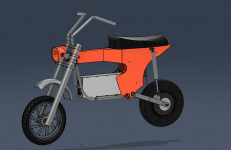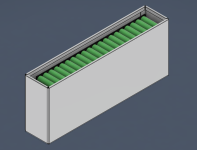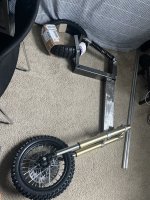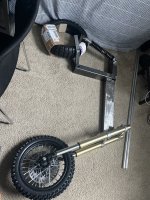Hello, this is my first post on the forums.
I am currently designing and fabricating an e-moped using a QS 12" 3000w 260 V4 hub motor and Votol em-150 controller. I am welding a rectangular tube frame and swing arm and using pit bike front forks. I plan to make a 72V 20s8p battery with EVE ICR18650 cells from Battery Hookup and potentially an ANT bms.

Figure 1: E-moped (MopEd?) complete assembly

Figure 2: Battery box mounting to frame tabs and down tubes.

Figure 3: Battery box cutaway showing cell arrangement. Note cooling fans have been eliminated in current design plans.
I've been going back and forth on two potential battery box design methodologies. My current design plan uses a laser cut acrylic enclosure that is slotted together and glued, with acrylic tabs that bolt into tabs welded to the tube frame as shown in figure 2. This design will be simplest for me to fabricate and will have built in cooling slots to keep battery temps low. I have several concerns with this design: my first is that the mounting methodology is likely to fail, with cracks forming along the plastic mounting tabs, my second is that in the event of a battery fire the box will do nothing to slow/contain the flames causing potential damage. Lastly, I worry about water entering the battery pack if riding through puddles or rain.
I've calculated that under worst case acceleration draw of 100A (over twice normal operating conditions), I will generate about 750 watts of waste heat inside the pack assuming average cell resistance of 75 mOhms. I live in a very hilly area with lots of traffic lights to start in, so I will likely be using the motors 3kW continuous (43 A) and peak 6kW (86A) draw frequently.
Looking at designs for high performance battery packs, Electro and Co for example, I see that their batteries have airtight sheet metal enclosures instead of plastic like smaller e-bikes. I created a rough sheet metal design for a lidded metal enclosure that is riveted together and held to the frame with clamps and latches instead of bolts, since I can no longer tab the sheet metal as in my plastic enclosure. This design solves my concerns over durability and water proofing, but I think the lack of airflow increases the likelihood of overheating the battery as well as condensation forming inside the battery box and having no way of escaping. I have the equipment to fabricate this box but I have less experience with sheet metal.

Figure 4: WIP design for sheet metal battery box.
I would like to call on the advice and experience of the forums in choosing a better design for my enclosure, plastic vs metal, air flow vs airtight, etc. What cooling methods or lack thereof are generally used in bikes of this caliber? Are metal enclosures actually airtight or do they have hidden cooling holes that I am missing? Can I passively radiate more heat than a legal ebike is allowed to have power in my area? How can I make my battery box bombproof and element proof?
I appreciate the advice and hope to post more on this project to the forums soon.
I am currently designing and fabricating an e-moped using a QS 12" 3000w 260 V4 hub motor and Votol em-150 controller. I am welding a rectangular tube frame and swing arm and using pit bike front forks. I plan to make a 72V 20s8p battery with EVE ICR18650 cells from Battery Hookup and potentially an ANT bms.

Figure 1: E-moped (MopEd?) complete assembly

Figure 2: Battery box mounting to frame tabs and down tubes.

Figure 3: Battery box cutaway showing cell arrangement. Note cooling fans have been eliminated in current design plans.
I've been going back and forth on two potential battery box design methodologies. My current design plan uses a laser cut acrylic enclosure that is slotted together and glued, with acrylic tabs that bolt into tabs welded to the tube frame as shown in figure 2. This design will be simplest for me to fabricate and will have built in cooling slots to keep battery temps low. I have several concerns with this design: my first is that the mounting methodology is likely to fail, with cracks forming along the plastic mounting tabs, my second is that in the event of a battery fire the box will do nothing to slow/contain the flames causing potential damage. Lastly, I worry about water entering the battery pack if riding through puddles or rain.
I've calculated that under worst case acceleration draw of 100A (over twice normal operating conditions), I will generate about 750 watts of waste heat inside the pack assuming average cell resistance of 75 mOhms. I live in a very hilly area with lots of traffic lights to start in, so I will likely be using the motors 3kW continuous (43 A) and peak 6kW (86A) draw frequently.
Looking at designs for high performance battery packs, Electro and Co for example, I see that their batteries have airtight sheet metal enclosures instead of plastic like smaller e-bikes. I created a rough sheet metal design for a lidded metal enclosure that is riveted together and held to the frame with clamps and latches instead of bolts, since I can no longer tab the sheet metal as in my plastic enclosure. This design solves my concerns over durability and water proofing, but I think the lack of airflow increases the likelihood of overheating the battery as well as condensation forming inside the battery box and having no way of escaping. I have the equipment to fabricate this box but I have less experience with sheet metal.

Figure 4: WIP design for sheet metal battery box.
I would like to call on the advice and experience of the forums in choosing a better design for my enclosure, plastic vs metal, air flow vs airtight, etc. What cooling methods or lack thereof are generally used in bikes of this caliber? Are metal enclosures actually airtight or do they have hidden cooling holes that I am missing? Can I passively radiate more heat than a legal ebike is allowed to have power in my area? How can I make my battery box bombproof and element proof?
I appreciate the advice and hope to post more on this project to the forums soon.



